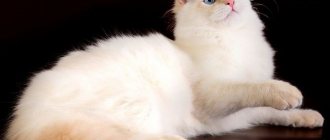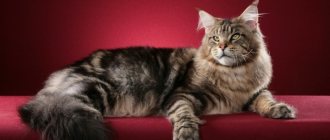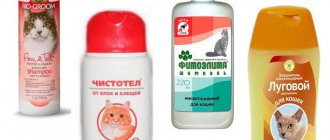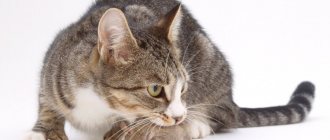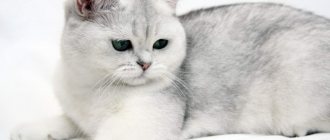Origin story
This energetic and stunningly charismatic representative of the cat family looks like a tiger.
Actually, this was what Judy Sugden was guided by when creating a new breed for lovers of wild predators. The work lasted from the end of 1980 until 2007, and included many cats (both outbred and purebred: Bengals). The TICA organization included toygers on its lists back in 1993, but cats were able to participate in exhibition events only 14 years later.
Toygers are not cheap: the price tag for a striped baby starts from 50,000 rubles and can reach 100,000-120,000 rubles (for breeding - 200,000). Such a high price is due to the fact that there are no nurseries in Russia where this breed would be bred, and animals have to be ordered from England through intermediaries.
HISTORICAL REFERENCE
Try to name the first breed of cats that comes to mind that are very similar to their wild relatives. Bengal? Is not it? The miniature cheetah is the brainchild of California breeder Jane Mill. The “progenitor” of the breed was madly in love with cats and was a first-class biologist-geneticist; the combination of the breeder’s work and hobby allowed the world to see Bengals.
Jane's daughter, Judy Sugden, was interested in her mother's work from a young age and when “the hour struck,” she made a loud statement about her intention to give the world a new breed of cat, a miniature copy of the tiger. Judy officially stated that her “brainchild” will remind people of tigers if the latter disappear from the face of the earth. In working on the breed, the girl used materials received by Jane when breeding Bengal cats.
The first breeder of the breed was the Jamma cat, which resembled a tiger in the shape of its head and ears. By the way, Judy brought Jammu from India in 1993, after which painstaking work began. The first official recognition of the toyger occurred in 2000, and 7 years later, tiger cubs joined the list of breeds of the International Cat Association.
It is worth noting that the breeding work has not yet been completed; every year, breeders (breeders) carry out careful selections and matings in order to reduce the size of the eyes, round the ears, obtain a lighter color on the abdomen, and increase the intensity of the color of the orange stripes. At the stage of formation of the breed, Judy crossed Bengals and Toygers to consolidate physical characteristics, but after the recognition of the tiger cubs, matings were stopped and prohibited. At the moment, there is a scheme that allows you to track the “purity of matings” of Toygers around the world.
Standard
The breeder spent a long time putting together the “puzzle” of the breed, trying to get a cat that was beautiful and strong, with the appearance of a tiger, but without giving the impression of being a clumsy and overly massive creature. Toygers have a wide bone, muscular build and a stretched body.
| Standard | Description |
| Head | Small in size, slightly elongated to the sides, with a rounded chin and plump whisker pads. |
| Eyes | Medium size, deep set, with yellow-green iris. |
| Nose | Quite long, with a large lobe. |
| Ears | Small, set wide apart, with rounded tips. The auricle is abundantly pubescent both inside and outside. |
| Torso | Massive, with a wide chest and medium-length limbs. |
| Paws | Elongated, elastic. |
| Tail | Long, thick, with a rounded tip. |
| Wool | The fur is short, elastic and dense. There are so-called fringes in the chin area and temples. |
The toyger is large in size, and the weight of females is 3.5-5 kg and the weight of males is 5-7.5 kg.
Disadvantages of the breed:
- A different shade of fur.
- Blue eyes.
- Malocclusion.
- A different shade for the tip of the tail.
Choose an active kitten with a good appetite. Weakness, lethargy, and cowardice can indicate both a weak character and some kind of disease.
Breed standard
The standard states that Toyger cats should be as similar to tigers as possible. But there are also specific features characteristic of representatives:
- toyger - a large cat (weighing from 7 to 12 kg in males and from 5 to 7 kg in females) with a massive and muscular body;
- the cat's muzzle should be elongated, narrow, with wide cheekbones and a strong chin;
- A distinctive feature of the toyger is its nose, it is much wider than that of most domestic breeds, very similar to a tiger, with a rounded bridge of the nose;
- ears are preferably small, round, wide and high set;
- the eyes are not set wide, deep-set, round with pointed tips, the outer tip is extended towards the ear;
- rich eye color, preferably with a greenish tint;
Almost all toygers have a green tint to their iris color. - the paws are massive, short, form a rectangle with the body;
- the back of the body is weighted;
- the profile of the toyger's head resembles a hexagon, the first half of which is part of the muzzle from the nose to the forehead, and the second is the forehead and back of the head;
- the bite is correct;
- long hair is very welcome on the temples and ears, but not lynx tassels;
- the coat is thick, short, dense, shine is possible, but it should not drown out the contrast of the pattern and background; on stripes and marks the hairs are slightly longer, which gives the coat an interesting texture;
- the undercoat is barely noticeable.
Color
According to the standard, the color and pattern on the toyger’s coat must meet the following parameters:
- stripes should be as contrasting as possible to the background;
- the abdomen should be light cream color;
- under the chin - a “wild spot”, a white mark; ideally, the belly and the “wild spot” should be the same color;
- stripes are welcome in plain, evenly colored, non-ticked (brownish, with an admixture of brown, gray) colors;
- the stripes on the body are vertical, the pattern continues on the neck and on the upper paws, and on the lower part of the paws the stripes are horizontal;
- on the muzzle there is a mark in the shape of the letter “M” inherited from the Bengals;
- the stripes on the muzzle are the most contrasting, on the cheeks they are horizontal, rounded near the eyes, slightly inclined, on the forehead they are vertical, converging, and do not extend to the neck;
- The presence of small elongated spots in the pattern is allowed;
- paw pads and tail tip are black;
- The stripe on the back typical of tabby colors is not allowed; the back must be darkened and have a pattern.
So far, only one color has been accepted as a standard - brown tabby mackerel, or brindle tabby. However, the type of pattern may vary. There are three types of drawing:
- mackerel stretched rosettes - rosette oblong;
The pattern type mackerel stretched rosettes looks like elongated rosettes - braided mackerel - striped;
The braided mackerel pattern is characterized by elongated stripes on the animal's skin. - zoned mackerel - zoned striped.
The zoned mackerel pattern looks like short stripes on the skin.
Since the toyger is a young breed, work on its appearance and standard is still underway. Breeders try to bring the cat’s exterior as close as possible to that of a tiger, in particular, to make the background of the skin brighter. A silver color has also been introduced.
Silver toygers are not yet recognized as a standard, but they already exist
Color
According to the standard, the basic coat color cannot be uniform. Light areas in the chest, paws and abdomen are required. The most common color is brindle (its second name is mackerel): a golden background with a red tint and vertical stripes of brown color. The undercoat may be greyish. There are light “spectacles” around the eyes, and a light spot on the ears (similar to a fingerprint. There are black dots on the whisker pads, and a black rim around the eyes and lips.
In the photo there is a Toyger cat of the correct color
Owners often offer silver toygers for sale: with a light background and brown stripes. These individuals have very soft and delicate fur, but they do not yet fall under the general standard.
Character and behavior
Toyger is a walking curiosity. There won't be a corner in your house that he won't poke his little nose into. And this, unfortunately, does not always look funny: a pan of boiling water, an electrical outlet, or an open balcony pose a real danger. With the appearance of a striped baby, you will have to forget the old habit of leaving pills and wires anywhere, otherwise the kitten will try to taste both.
He is playful, but will not run around the house like a fury and knock everything off the shelves. He is absolutely not vindictive and will easily forgive you for trampling his tail, for stuffing him with deworming pills, and for carrying him around in a carrier. Trusting and sociable: he quickly goes into the arms of guests. Excellently trainable and easily learns new commands.
Children are the best friends for a Toyger. It is unthinkable for a cat to offend a baby, so they obediently endure all the games and tail-pulling. They love to sleep with children in the same bed.
The toyger knows how to get along not only with representatives of the human race, but also with other animals. And not only their own kind, but also dogs, small rodents and similar living creatures. These individuals have no hunting instinct, which means: your favorite hedgehog can calmly stomp around at night, without fear of getting into the teeth of a zealous hunter. The toyger will not be jealous when he sees that you are paying attention to another pet, and even more so, he will not take revenge.
Character of Toyger cats
Many people are alarmed by the strict and predatory appearance of the Toyger cat. But despite its appearance, this pet is endowed with a very friendly and flexible character. The kitten adapts well to life in the house and gets along with all family members, whom he considers his pack. Toygers are very sociable, loving, playful, do not try to dominate people and do not consider themselves masters of the house. These pets love children very much and always protect them, considering them kittens that need protection.
Toygers also have the character trait of being unobtrusive. Cats love to follow their beloved owner around the house and accompany him everywhere, but one glance is enough for the toyger to understand that the person wants to be alone. They also do not like to be picked up against their will and shown excessive affection.
Care instructions
Wool
The Toyger's short coat does not require special manipulation. It does not roll into tangles, and molting occurs only once a year and is almost imperceptible. To care for it, you just need to buy a rubber brush.
Bathing
Toygers are indifferent to bathing: they are unlikely to get into the water themselves, but they will not be particularly indignant about bathing procedures. Buy a mild cat shampoo that does not contain coloring ingredients, and bathe the animal once every six months or when dirty.
Does your cat like to swim?
Not really
Ears
The ears are examined once a month, and dirt is removed with a damp swab.
Teeth
You will also have to brush your teeth at least once a week, using a soft toothbrush (you can use a children's brush) and cat toothpaste.
Claws
It is not necessary to cut their claws: toygers quickly learn to grind them off on scratching posts.
Story
The breed was bred in the USA under the strict guidance of Judy Sugden, who is the daughter of a famous breeder of Bengal cats.
The first representative of the future Toygers was just born in the litter of a representative of the Bengal breed - this happened in 1988, and from that moment selection work began.
Later, Anthony Hutcherson and Alice McKee joined the process - the fruit of their union work was the official registration of the breed in 2007.
There are only a few nurseries with toygers on the territory of the Russian Federation, and the largest of them is located in the city of Zelenograd.
Catering
A balanced and high-quality diet is a must if you want to raise your pet healthy and strong.
But food from your own plate is not suitable: fried, smoked, sweet foods are death for a cat's stomach. You will have to follow a number of rules. Don't be afraid: there is nothing complicated about them.
Natural products
When choosing natural food, follow the recommendations of the breeder and veterinarians. Both of them strongly recommend not feeding the animal salty and sweet dishes, pickled foods, baked goods, citrus fruits, and sweets (chocolate is strictly prohibited).
List of permitted products:
- lean meats: beef, veal, rabbit, turkey, rabbit;
- fish: flounder, hake, salmon, trout, cod;
- dairy and fermented milk products: low-fat cottage cheese, sour cream, yogurt, cream, natural yogurt;
- vegetables: zucchini, pumpkin, carrots, broccoli, asparagus, green salad;
- cereals: buckwheat, rice, millet, oatmeal, pearl barley;
- purified drinking water (temperature comfortable for the animal).
The presence of dyes, GMOs, artificial and chemical components in food is not allowed.
Recommended food
You can also feed your cat commercial food. Modern food is affordable and formulated taking into account all the basic needs of the animal.
Experienced breeders advise buying food from holistic groups: Primordial, Pronature Holistic, Savarra. Super premium: Naturea, Vigor & Sage, Vet Life. The rest (premium and economy class) have a poor composition and too many questionable components in the composition (for example, artificial preservatives, flavor enhancers, etc.).
Below are recommended super-premium foods. Links with the names of the food are clickable, on them you can, within our website, get acquainted with the descriptions of the food and read reviews from owners of Toyger cats.
| Holistic | Super premium | Super premium |
| Riverwood | Optima Nova | Monge |
Pet care
The toyger's fur, eyes, ears, claws and teeth require careful and attentive care.
Grooming
What you will need to care for your toyger's coat:
- rubber massage brush;
- combined comb;
- slicker;
- double-sided brush;
- conditioning shampoo or regular cat shampoo;
- texturizing shampoo;
- dry shampoo;
- rubber massage sponge;
- vitamins for wool.
Vitamins for cat hair will help improve coat texture, reduce hair loss, add shine and enhance growth.
Photo gallery: vitamins for the fur of a “toy tiger”
Excel Brewer's Yeast is a complex supplement that contains garlic and brewer's yeast.
The advantage of Canina Canivita vitamins is that it improves the quality of cats’ fur - it stops matting and becomes smooth and shiny.
Doctor Zoo vitamins can be given to a variety of feeding methods - both to cats eating dry food and to cats eating natural food.
The main purpose of Gimpet paste with TGOS is to remove hair and food debris from the stomach, the presence of which causes regurgitation and stomach problems
FeliDerm are vitamins from the German manufacturer AniVital, the main action of which is aimed at improving the condition of the skin and coat of cats.
The toyger has short hair, with a sparse undercoat, so it needs to be combed no more than 1-2 times a week (during the molting period, from 4 times to daily combing). How to do it:
- First, the cat is combed with a slicker brush.
- Then, using a combined comb, remove large fallen hairs.
- Finish combing with a double-sided brush with sparse teeth (first comb with iron teeth, then with bristles).
- Use a rubber brush to comb the wool. This will remove any remaining dead hair and provide a gentle massage.
Toyger coat care is simple, but necessary.
Photo gallery: grooming tools
Using a glove can help clean your cat's fur better.
A rubber massage brush increases blood flow to the coat, which improves its growth, gives it health, shine and strength.
The bristles on the double-sided brush allow you to remove almost all hairs
A slicker brush with frequent, short teeth is suitable for a toyger.
A combination comb straightens the coat and removes dead guard hairs.
The toyger should be washed no more than once every 2-3 months (if the cat walks outside - once a month), and also before the exhibition. In the intervals between washing, once every 2 weeks, the cat is combed as described above, but after applying dry shampoo to the coat.
Photo gallery: shampoos for Toyger
Jerob texturizing shampoo for cats is safe and effective
Elite Professional texturizing shampoo gives the coat a beautiful shine
BioGroom ExtraBody shampoo is suitable for both cats and dogs
Jerob Herbal Shampoo contains herbal extracts, and its concentration allows you to use it sparingly
BioGroom Protein-lanolin shampoo contains two very important substances for a cat’s coat - protein and lanolin.
Tropiclean Papaya&Coconut shampoo gently cares for cat fur
Shampoo-conditioner Rolf Club is intended for short-haired cats
Shampoo Ms. Kiss “Fluffy Tail” is hypoallergenic and does not contain aggressive substances, so it is suitable even for kittens
Dry shampoo Tropiclean Waterless Shampoo protects your cat from dandruff
Pet's Lab dry shampoo cleans hair well
Trixie dry shampoo cleans hair just as well as liquid shampoo, but make sure it doesn't stay in your cat's coat.
Nail care
Your pet's nails should be trimmed as they grow, about once a month. Here's how to do it correctly:
- Take the cat's paw in your hand and gently press on the pad so that the claw is fully exposed.
- Examine it and determine where the pink part with the vessels is located, and where the transparent cuticle is.
- Using a nail clipper, carefully cut off the transparent part, leaving about 2 mm from the body (pink part) of the claw.
- If you still cannot avoid a cut, treat the wound with hydrogen peroxide and cauterize it with iodine.
It is not necessary to trim the claws if the cat uses a scratching post.
You need to trim your cat's claws at a slightly angled angle.
Anti-scratch kits are another solution designed to protect your cat's interior items and claws. Many owners believe that anti-scratch products are harmful. But in fact, they are not dangerous - a claw with caps on it functions the same as a free one. Anti-scratch pads should not be used unless the cat is allergic to the glue that is used to attach them.
Anti-scratch pads do not cause discomfort to the cat
Under no circumstances should an onychectomy be performed - complete surgical removal of the claws. The vast majority of veterinarians are against such surgery. There are many risks: the claw may regenerate and grow into the paw, the cat may lose the ability to coordinate movements, and there is also a high risk of infection through wounds in the paw. In addition, the postoperative period is very painful. The operation itself is prohibited in many countries and is cruel to the animal.
Care for ears, teeth, eyes
The procedure for caring for the teeth, ears and eyes of a toyger is as follows:
- Ears are cleaned once every 5 days. The cleaning method depends on the dirt: The first method is used for severe dirt. For cleaning you will need cotton swabs with a limiter and ear cleaning lotion. Use a stick soaked in lotion to carefully remove wax from your cat's ear. Try to clean out the wax, and not push it into the ear canal. Do not push the stick too deep or use force to avoid damaging your ear.
- The second method is used for regular cleaning. All you need is special ear cleaning drops. Place 4-5 drops into the ear and gently massage the base for 1-2 minutes.
Photo gallery: everything you need to care for a toyger
Ear cleaning lotion is used for severe dirt.
The stopper on a stick protects the cat's ears from injury
If your cat's gums are weakened, it is better to use a softer brush.
If your pet has healthy gums, use a special brush for cats.
Ear cleaning drops are used for mild dirt.
Do not apply too much toothpaste to your brush.
Diseases
No genetic diseases have been identified in this breed, and no serious diseases have been reported either. The most your pet can suffer from is a common cold. Therefore, make sure that the animal does not lie in a draft and does not freeze after bathing.
Vaccinations are required if you love your pet and want him to be healthy. Even if you do not let your cat go for walks, pathogens can easily be brought home on your own hands (if you stroke the animal with unwashed hands), but on the soles of shoes or street clothes.
Rabies, rhinotracheitis, panleukopenia, calcivirosis are deadly diseases from which the animal must be protected. Currently, there are a number of complex vaccines (which contain not one, but several components), which are administered from an early age (6-10 weeks). Repeated vaccinations are given once a year. Popular vaccines on the domestic market: Nobivak (Tricket and Forcat), Quadrikat, Leukorifelin, Multifel-4, Fel-O-vax), Primucel.
Expert opinion
Dusheba Vera Ivanovna
In 2010, she graduated from the Moscow State Academy of Veterinary Medicine named after K.I. Scriabin with honors, specializing in veterinary medicine. I regularly attend veterinary conferences, congresses, and webinars.
Before vaccination, be sure to give your cat anthelmintic medications. But not human ones - they will cause poisoning! - and special ones, for animals. Before purchasing the drug, be sure to consult your doctor. It is impossible to drive worms from pregnant cats (in the first half of the term), in the presence of infectious diseases, pathologies of the urinary system and liver, as well as in kittens under 6 weeks of age.
Photo gallery
Below are photos of Toyger cats.
Character
Toygers are very friendly cats that love to be with people. They are smart and sociable and get along well with children and other animals. They are easy to teach household rules, games and even tricks.
The Toyger cat is calm and flexible. Therefore, given their exotic color, it seems that you have a real tiger at home - balanced and measured. These cats are moderately active, so they won’t tire you out. They will be happy to cuddle in your arms while watching TV or reading a book.
Toygers are not very loud, and if they do voice, they do it softly and unobtrusively. Many representatives of this breed love to swim in the water.

